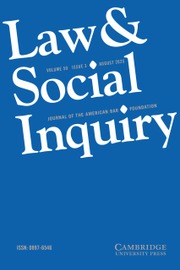Article contents
Many Shades of Success: Bottom-up Indicators of Individual Success in Community Courts
Published online by Cambridge University Press: 03 November 2023
Abstract
This study challenges the conventional approach to the appropriate indicators of individual success in community courts (CCs) by exploring the different meanings that CC professionals ascribe to the term “success.” CCs conduct a non-adversarial process in which team members collaborate to provide a comprehensive rehabilitative intervention for recidivist participants. We conducted fifty-three in-depth interviews with CC personnel between 2016 and 2020. According to the interviewees, standard evaluation measures such as program completion, reduced recidivism, and systemic reduction of incarceration are necessary for evaluating these courts. Yet individual success is relative, subjective, multidimensional, and must be understood as a continuum. Therefore, it should also be measured by looking at significant processes of change that participants have undergone in various aspects of their lives. Study findings can be translated into measurable well-being indicators, moving the “what works” discourse forward to include more nuanced and diverse manifestations of success in studies evaluating specialized courts.
- Type
- Measures of Justice: A Symposium in Honor of Sally Engle Merry (1944–2020)
- Information
- Copyright
- © The Author(s), 2023. Published by Cambridge University Press on behalf of the American Bar Foundation
Footnotes
We would like to thank, first and foremost, our interviewees who opened their minds and hearts and shared with us their visions and perspectives based on their firsthand experience with the Israeli community courts (CC) program. Special thanks to Daniella Beinisch and Shlomi Cohen from Joint-Ashalim for supporting the project and for providing valuable guidance throughout the research. We are also grateful to Shefa’a Abu-Jabal, Tamar Ben-Dror, Gali Pilovski-Menkes, Yarin Segev, and Noa Yosef for outstanding data collection and research assistance and to Amit Doctor for technical assistance. The study has received approval from the University of Haifa Institutional Review Board. The study was funded by Joint-Ashalim, Grant no. 207083 (formative study) and Grant no. 205085 (evaluation study)
References
REFERENCES
- 1
- Cited by


